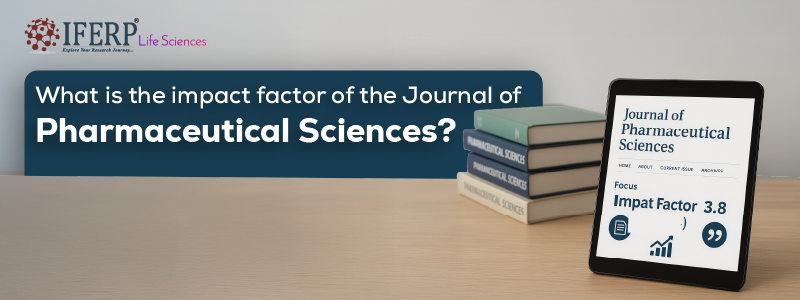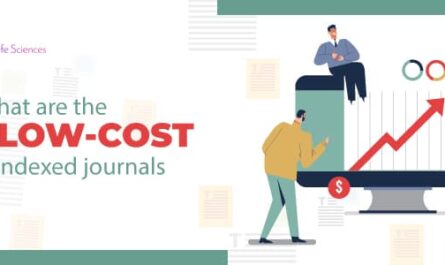About the Journal of Pharmaceutical Sciences
Among the top journals in pharmaceutical research, the Journal of Pharmaceutical Sciences has stood tall for ages and continues to retain its spot even now. It is published by Elsevier on behalf of the American Pharmacists Association.
As per the latest data, the impact factor of the Journal of Pharmaceutical Sciences is around 3.8, which is a solid number in this field. You will understand why by the end of this blog. What makes this journal particularly respected is not just the impact factor number attached to it but the consistency with which it publishes high-quality research and covers every aspect of modern pharmaceutical science. For all the researchers looking to publish their findings in an internationally recognized platform, this journal becomes the first choice.
What is the Impact Factor of the Journal of Pharmaceutical Sciences?
When you start your research journey and reach the stage of academic publishing, you will frequently come across one phrase everywhere — impact factor. For researchers in the field of medicine, pharmacy, chemistry, biotechnology and allied sciences, it’s often seen as a symbol of acknowledgement and credibility. But many are still not aware of its meaning. So what does it really mean? And how do popular journals like the Colombian Journal of Chemical Pharmaceutical Sciences compare when it comes to this metric? Let’s understand all this through this blog.
Understanding the concept of Impact Factor
· Impact factor is a reflection of how frequently a journal’s articles are cited in other research papers. In the academic world, citations are very important as they create the trust among academicians.
· Every time someone refers your article in a research paper, it signals that your work has influenced theirs and that it is very relevant. The more citations a journal’s articles receive, the higher will be its impact factor.
· However, it’s important to remember that an impact factor measures a journal’s overall influence such as the Colombian journal of chemical pharmaceutical sciences impact factor.
· However, it is also important to understand that it need not necessarily indicate the quality of every single article it publishes. It’s calculated annually by Clarivate Analytics through the Journal Citation Reports (JCR).
· So, while a high impact factor does indicate a respected publication, it’s not the only thing that matters finally, there are other factors such as peer review standards, editorial board reputation, indexing etc.
What is the Colombian Journal of Chemical Pharmaceutical Sciences?
Now, let’s turn our attention to a more region specific publication — the Journal of Chemical and Pharmaceutical sciences Impact Factor. This journal often comes up in conversations among scholars looking for South American journals with a chemistry–pharmacy topic primarily. It plays an important role in providing a platform for regional research, particularly in the South American region, where there is a growing emphasis on pharmaceutical and chemical innovation.
When it comes to the Colombian Journal of Chemical Pharmaceutical Sciences impact factor, there is no impact factor available as of now. You might find references online that suggest it has an impact score or ranking, but it is mostly from secondary or unverified databases. This does not mean the journal isn’t valuable or credible. The journal plays a crucial role in changing ideas to innovations.
What is Indexing and Visibility?
· For any academic journal, indexing determines how easily researchers across the world can find your work among the thousands of articles published.
· Indexes like Scopus, Web of Science, PubMed etc are considered to be very reputed ones.
· Some sources claim that the Colombian Journal of Chemical Pharmaceutical Sciences indexing is done in Scopus.
· If it is indeed indexed, it will enhance its global reach. When publishing your work, it’s better to check the indexing status directly from the indexing database rather than any third-party listings which might be fake.
· It ensures your research appears in reputable channels instead of some random fake websites and contributes to your academic credibility meaningfully.
What about the Publication Fees and Charges?
· Another common concern which researchers have is the publication fee. Many journals today charge a huge amount from the authors for processing and publishing their papers.
· In the case of the Colombian Journal of Chemical Pharmaceutical Sciences publication fee, there isn’t clear public information.
· Some sites mention that the Colombian Journal of Chemical Pharmaceutical Sciences publication charges may apply, but the details are not clear or transparent on the journal’s official website.
· The best way to get this information is to reach out to the editorial team directly before submission and ask for confirmation about this.
Here is a tip- Don’t get trapped with some hidden fees or last-minute payment requests. This can be a way to loot your money by scammers. Always ensure you receive a clear invoice from the publisher before proceeding with any payment.
Which Pharmacy Journal Has the Highest Impact Factor?
If we move from specific journals to the next level, we might wonder: Which pharmacy journal has the highest impact factor? The answer is not fixed and changes slightly every year. However, there are few journals which are consistently top-ranked for several years such as Nature Reviews Drug Discovery, Advanced Drug Delivery Reviews etc. These journals not only have high-impact factor but also publish typically large-scale, well-funded research studies or critical reviews each year.
Which Chemistry Journal Has the Highest Impact Factor?
For those who are interested in chemical sciences, the list of journals having high impact factor is just a few such as Chemical Reviews and Nature Chemistry. They usually hold the top spots, with very high impact factors soaring well above 20 and sometimes even 50. These journals are incredibly competitive and so if your work lies at the intersection of chemistry and pharmaceuticals, these journals are something which you much consider for sure.
Is the Journal of Chemical Sciences Q1 or Q2?
To those first wondering what is quartile ranking? Quartile ranking classifies journals into four groups -Q1. Q2, Q3 and Q4 based on their impact or citation performance within a specific subject area. Q1 represents the top 25% of journals, while Q4 indicates the lowest 25%.
Colombian journal of chemical pharmaceutical sciences scopus, indexed in the Scopus publications is another widely discussed journal in this quartile rankinh category. Its quartile ranking can vary depending on the indexing database and subject category. The journal usually has a ranking of Q2, occasionally moving to Q3 in some categories. This means it’s a solid respected mid-tier publication accessible to a wide community of chemists and pharmaceutical researchers.
Bonus Tips for Choosing the Right Journal
If you’re a person new to the field of research still confused about where to submit, here are a few friendly tips:
- Check indexing first whether the journal appears in Scopus, Web of Science, or PubMed which are the most reputed ones.
- Read a few recent papers because it’ll help you understand the present writing style and research focus that is relevant and widely accepted.
- Have a clear idea about the publication fees in the beginning itself.
- Look for genuine peer review and scrutiny by editorial boards.
- Have patience while choosing reputed journals because they will take a longer time for acceptance. Avoid journals that promise acceptance within days.
Frequently Asked Questions (FAQs)
The Journal of Pharmaceutical Sciences has an impact factor of around 3.8 as per the latest reports from Clarivate’s Journal Citation
There’s currently no official Clarivate-listed impact factor available for the Colombian Journal of Chemical Pharmaceutical Sciences in any authentic source.
Some websites do mention Scopus indexing, but there’s no verified confirmation from Scopus itself. Frequently cross-check on the Scopus database as it is updated on a regular basis.
The journal does not display any transparent information about publication charges. So it is better to contact the editorial team directly to inquire about any fees.
The journal claims an impact factor of 1.421, but it isn’t listed in the official database.
Nature Reviews Drug Discovery and Advanced Drug Delivery Reviews are among the highest, with impact factors above 10 for several years.
Chemical Reviews and Nature Chemistry usually top the list, often exceeding 20 or even 50 in their reported impact factors.
It typically falls around Q2, but varies year on year.
Conclusion
Now that we’ve gone through the data, let’s pause for a moment to question ourself. Does an impact factor really define the worth of a journal or a researcher? The answer is no, not entirely. Impact factors can guide you toward reputable journals, but they don’t give the full picture. It is important for you to know that many specialized or regional journals contribute significantly to their fields without having any such metrics. A well-cited article in a Q3 journal can be more impactful than an unnoticed paper in a Q1 title.




